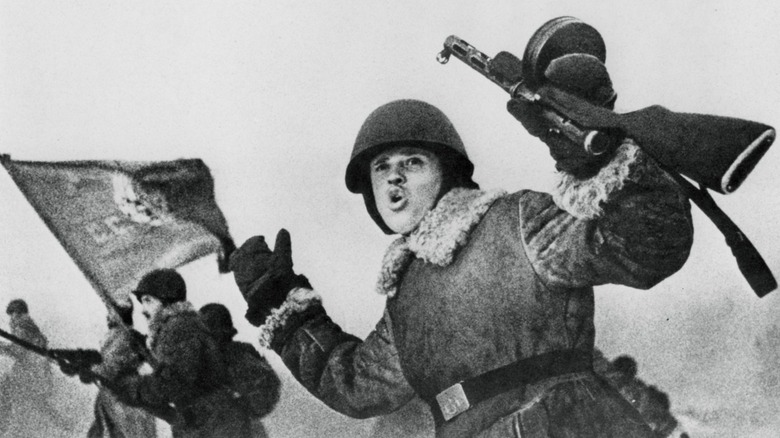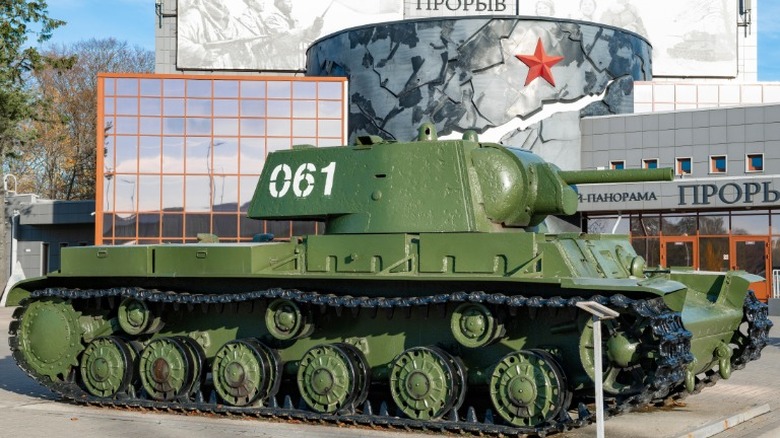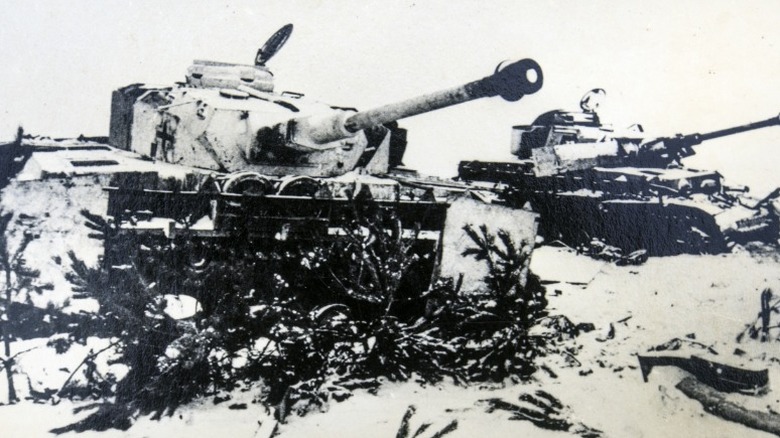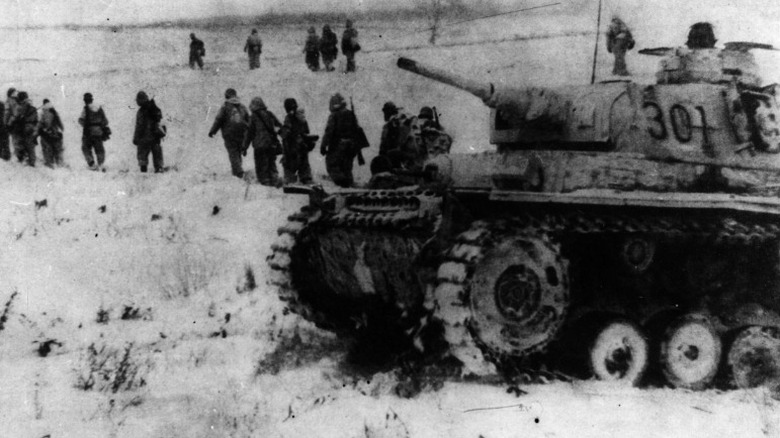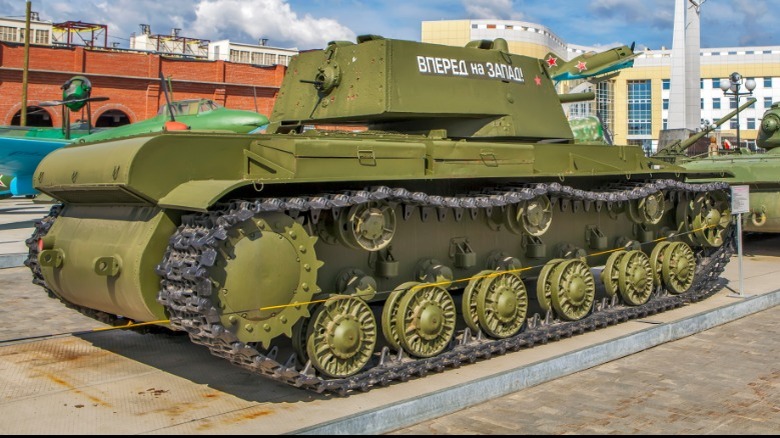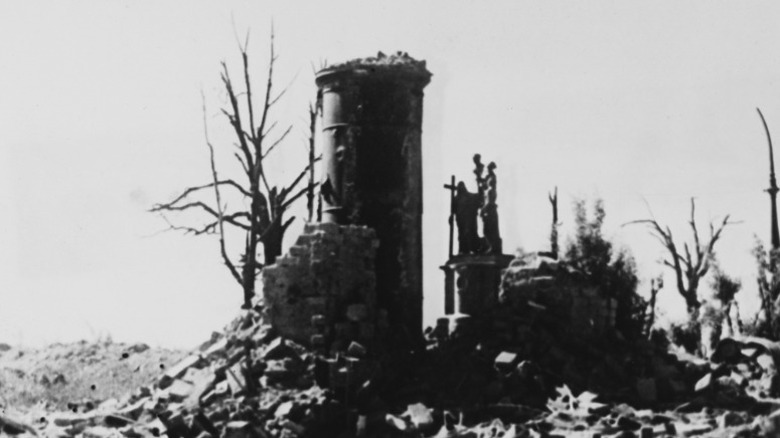The True Story Of One USSR Soldier's Miracle Victory During The Battle Of Stalingrad
Adolf Hitler's decision to break a non-aggression pact with the Soviet Union in 1941 escalated the war in Europe that had been building since the Nazi leader rose to power. Committing the German troops to carry out Operation Barbarossa, Hitler hoped to cripple the Red Army in several strategic locations along the Eastern Front (via History). The attack focused on three areas, using the force of more than 3 million German soldiers. One unit focused on attacking the Soviets in Ukraine, while another headed toward Moscow. The third prong of the attack moved north along the eastern European nations of Lithuania, Latvia, and Estonia. They had their eye on the prize that lay at the base of the Neva River, where the waterway emptied into the Baltic Sea — the city of Leningrad.
The port city was one that Hitler knew would be a key grab for Germany. The abundance of factories in Leningrad would no doubt be used by the Soviets to generate munitions and other needed wartime materials, and it was also where the Soviet navy's Baltic fleet operated. As the Germans and their Finnish allies began to move toward Leningrad, the Red Army and civilian volunteers worked to fortify the city against the inevitable arrival of German tanks that would soon be rolling in. As the cities leading to Leningrad began to fall one by one, Leningrad's roadways and railways began to be cut off from the rest of the world. Within several months, the city was surrounded by German and Finnish forces. A full-on siege was beginning.
Lieutenant Zinovy Kolobanov was handed an impossible assignment
Senior Lieutenant Zinovy Kolobanov met with the division leader, General V.I. Baranov, as the German tank units were making their way to Leningrad (via Armor). In the basement of one of the churches in the city, Baranov gave orders to Kolobanov to use the tanks under his command to keep the enemy from advancing. Kolobanov had five KV-1 tanks that he was in charge of, certainly no match for the scores of units that the Germans would soon send rolling down the roadways to Leningrad.
According to The National Interest, the KV-1 tanks were superior to the ones the Germans were using for their invading forces in one way — the armor on these machines was much thicker and could take a good beating. But they weren't as mobile as many of the other model tanks being used, mostly due to a weak transmission that made them slower and more difficult to maneuver.
Probably aware of the strengths and weaknesses of the rolling weapons he had to work with, Kolobanov had to quickly come up with a strategy that would best use what he had available to him. Better, more evolved tanks would soon be developed and used by the Soviets as the war progressed, but for now, the lieutenant had to make do with what was there. As it would turn out, his knowledge of the lay of the land and his quick thinking would prove to be just as powerful as the shells that the crews were loading into the Soviet tanks.
Kolobanov and his crews were facing 22 German tanks on the first wave
The Soviet tanks were loaded with armor-piercing shells and "high-explosive fragmentation shells" (per Armor). Zinovy Kolobanov had orders to protect three roads — one that led to the city of Volosovo, the Luga road, and the Tallinn highway with the road to Marienburg. Kolobanov gave orders to send two tanks to protect each of the first two positions, with him taking the latter. He gave instructions for each crew to dig two separate shelters for each tank. Shielded with their positions dug, the waiting game began.
On the morning of August 19, 1941, the German bombing raids began. Several hours passed before Kolobanov was informed by radio communication that the Red Army had encountered German tanks near their positions. They waited patiently as the procession of German tanks was heading toward them, first letting the German military motorcycles drive by without attack. The drivers did not notice the heavily camouflaged Soviet tanks and proceeded along the route.
The German tanks appeared next, moving in single file. As they rumbled down the roadway near Kolobanov, he was able to get their number at 22. He gave his gunner the order to open fire on the lead tank. The single shot from the KV-1 was a direct hit, and the German unit quickly caught fire and became completely immobilized.
Kolobanov's strategy boxed in the enemy quickly
With the first tank in the long procession of German Panzers out of commission, Zinovy Kolobanov continued his strategy. Armor reports that a second shot disabled the second tank in the German column, creating a bottleneck. But instead of firing at each tank down the row, Kolobanov employed a different mode of attack, as the quick destruction of the two tanks in the lead narrowed the spaces between the tanks in the column as each rolled to a stop behind the fiery destruction on the roadway.
Kolobanov ordered his gunner to set his sights on the rear of the line of tanks (per Russia Beyond). Though the first shot didn't make contact, the following four shots fired from the KV-1 found their marks and took out the two Panzer tank units in the rear. This tactic trapped the remaining 18 tanks on the roadway. The swampy terrain on either side made their escape nearly impossible.
Up to this point, the German units did not even know where they were being attacked from. But the subterfuge that Kolobanov had orchestrated came to an abrupt end, and the Germans opened fire, shelling Kolobanov's tank with an intense amount of fire. It was one Red Army KV-1 against a respectable number of German Panzers. And that was just the battle on one road.
As this standoff waged on, Kolobanov heard through radio contact that the other tanks under his command were now engaging the enemy. The two tanks guarding Luga road destroyed 13 enemy units. The remaining tanks destroyed an additional eight.
The column is destroyed
As German infantry arrived to support the Panzers that were under attack, Zinovy Kolobanov was alerted to the anti-tank artillery that was being quickly put into place. He ordered his gunner to fire the high-explosive fragmentation projectiles at the anti-tank guns that would surely end the standoff if they honed in on his KV-1 (per Armor). While he was able to destroy one anti-tank unit, the gunner missed the second one. The surviving unit was able to get a hit on the KV-1, disabling the panoramic periscope and damaging the tank's tower. The KV-1 would only be able to move the aim of its gun by moving the hull of the tank, but Kolobanov was not going to give up.
He ordered the tank to abandon its primary position and retreat to the reserve position that had been established before the Panzers arrived. The KV-1 backed out and got into position with the remaining tanks on the road in its sights. One by one, the KV-1 fired on the remaining Panzers until all 22 had been destroyed. Altogether, a tank company that only numbered five armored units destroyed 43 German Panzers. After the battle was over, the KV-1 Kolobanov was aboard was noted to have suffered more than 150 shots from German fire, none of which were able to pierce the thick armor that shielded its occupants. For his efforts, Kolobanov was awarded the Order of the Red Banner of War.
The Belarusian Telegraph Agency reports that Kolobanov retired as a Lt. Colonial and later worked for Minsk Auto Works. He died in 1995.
The siege could be considered a genocide
The casualties from the siege of Leningrad would prove to be staggering. According to History, an estimated 800,000 civilians perished during the 900-day ordeal. Food and fuel scarcities, greatly amplified by the city being almost entirely cut off from Soviet supply lines, led to many of the city's people starving or freezing to death. During the first winter of the siege, it's believed that the city was losing 100,000 civilians each month. Those who were faced with death by starvation would resort to eating whatever they could scavenge, whether it was a rodent that they could catch or their household pets. During what was known as the "Hungry Winter," some people in Leningrad turned to acts of cannibalism to survive.
The siege of Leningrad is considered a testament to the Russian people's determination. For nearly three years, the civilians and the Soviet government worked to open new supply lines into a city under heavy attack, managing to slowly evacuate hundreds of thousands of civilians and bringing in much-needed supplies to those who remained and the troops that protected them. Indeed, the intent of Hitler toward Leningrad was clear: Cut the city off from the rest of the world and let the people there die from starvation or bombing raids. It's looked at by some historians as genocide, though it has not been officially recognized as one. TASS reports that in September 2022, a prosecutor in St. Petersburg (formerly Leningrad) filed a petition with the city to have the German siege recognized as a war crime and genocide.
